874 books about Animals and 6
start with J
874 books about Animals and 6
874 books about Animals
6 start with J start with J
6 start with J start with J
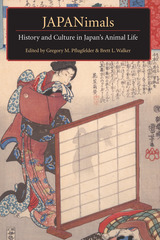
JAPANimals
History and Culture in Japan’s Animal Life
Gregory M. Pflugfelder and Brett L. Walker, Editors
University of Michigan Press, 2005
From swift steeds to ritually slaughtered deer to symbolic serpents, nonhuman animals of every stripe have participated from the earliest of times in the construction of the cultural community that we know as Japan. Yet the historical accounts that have hitherto prevailed, claim the authors of this innovative volume, relegate our fellow animals to a silent and benign “nature” that lies beyond the realm of narrative and agency. What happens when we restore nonhuman creatures to the field of historical vision?
This book challenges many of the fundamental assumptions that have shaped contemporary scholarship on Japan, engaging from new perspectives questions of economic growth, isolation from and interaction with the outside world, the tools of conquest and empire, and the character of modernity. Essay by essay, this provocative collection compels readers to acknowledge the diversity of living beings who exist at the ragged edges of our human, as well as our historical, horizons.
[more]
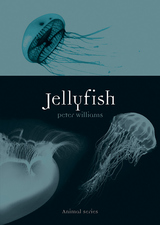
Jellyfish
Peter Williams
Reaktion Books, 2020
Jellyfish are, like the mythical Medusa, both beautiful and potentially dangerous. Found from pole to tropic, these mesmeric creatures form an important part of the sea’s plankton and vary in size from the gigantic to the minute. Perceived as almost alien creatures and seen as best avoided, jellyfish nevertheless have the power to fascinate: with the sheer beauty of their translucent bells and long, trailing tentacles, with a mouth that doubles as an anus, and without a head or brain. Drawing upon myth and historical sources as well as modern scientific advances, this book examines our ambiguous relationship with these ancient and yet ill-understood animals, describing their surprisingly complex anatomy, weaponry, and habits, and their vital contributions to the ocean’s ecosystems.
[more]
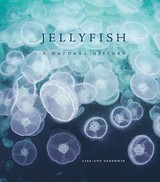
Jellyfish
A Natural History
Lisa-ann Gershwin
University of Chicago Press, 2016
Jellyfish, with their undulating umbrella-shaped bells and sprawling tentacles, are as fascinating and beautiful as they are frightening and dangerous. They are found in every ocean at every depth, and they are the oldest multi-organed life form on the planet, having inhabited the ocean for more than five hundred million years. In many places they are also vastly increasing in number, and these population blooms may be an ominous indicator of the rising temperatures and toxicity of the world’s oceans.
Jellyfish presents these aquarium favorites in all their extraordinary and captivating beauty. Fifty unique species, from stalked jellyfish to black sea nettles, are presented in stunning color photographs along with the most current scientific information on their anatomy, history, distribution, position in the water, and environmental status. Foremost jellyfish expert Lisa-ann Gershwin provides an insightful look at the natural history and biology of each of these spellbinding creatures, while offering a timely take on their place in the rapidly changing and deteriorating condition of the oceans. Readers will learn about immortal jellyfish who live and die and live again as well as those who camouflage themselves amid sea grasses and shells, hiding in plain sight.
Approachably written and based in the latest science and ecology, this colorful book provides an authoritative guide to these ethereal marine wonders.
Jellyfish presents these aquarium favorites in all their extraordinary and captivating beauty. Fifty unique species, from stalked jellyfish to black sea nettles, are presented in stunning color photographs along with the most current scientific information on their anatomy, history, distribution, position in the water, and environmental status. Foremost jellyfish expert Lisa-ann Gershwin provides an insightful look at the natural history and biology of each of these spellbinding creatures, while offering a timely take on their place in the rapidly changing and deteriorating condition of the oceans. Readers will learn about immortal jellyfish who live and die and live again as well as those who camouflage themselves amid sea grasses and shells, hiding in plain sight.
Approachably written and based in the latest science and ecology, this colorful book provides an authoritative guide to these ethereal marine wonders.
[more]
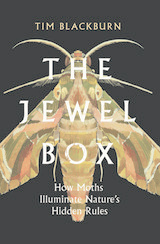
The Jewel Box
How Moths Illuminate Nature’s Hidden Rules
Tim Blackburn
Island Press, 2023
A plastic box with a lightbulb attached may seem like an odd birthday present. But for ecologist Tim Blackburn, a moth trap is a captivating window into the world beyond the roof terrace of his London flat. Whether gaudy or drab, rare or common, each moth ensnared by the trap is a treasure with a story to tell. In The Jewel Box, Blackburn introduces these mysterious visitors, revealing how the moths he catches reflect hidden patterns governing the world around us.
With names like the Dingy Footman, Jersey Tiger, Pale Mottled Willow, and Uncertain, and at least 140,000 identified species, moths are fascinating in their own right. But no moth is an island—they are vital links in the web of life. Through the lives of these overlooked insects, Blackburn introduces a landscape of unseen ecological connections. The flapping of a moth’s wing may not cause a hurricane, but it is closely tied to the wider world, from the park down the street to climatic shifts across the globe.
Through his luminous prose and infectious sense of curiosity, Blackburn teaches us to see—and respect—the intricate web of nature in which we’re all caught. The Jewel Box shows us how the contents of one small box can illuminate the workings of all nature.
With names like the Dingy Footman, Jersey Tiger, Pale Mottled Willow, and Uncertain, and at least 140,000 identified species, moths are fascinating in their own right. But no moth is an island—they are vital links in the web of life. Through the lives of these overlooked insects, Blackburn introduces a landscape of unseen ecological connections. The flapping of a moth’s wing may not cause a hurricane, but it is closely tied to the wider world, from the park down the street to climatic shifts across the globe.
Through his luminous prose and infectious sense of curiosity, Blackburn teaches us to see—and respect—the intricate web of nature in which we’re all caught. The Jewel Box shows us how the contents of one small box can illuminate the workings of all nature.
[more]
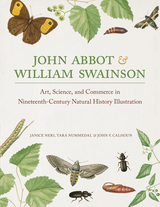
John Abbot and William Swainson
Art, Science, and Commerce in Nineteenth-Century Natural History Illustration
Janice Neri, Tara Nummedal, and John V. Calhoun
University of Alabama Press, 2019
An archive of never-before-published illustrations of insects and plants painted by a pioneering naturalist
During his lifetime (1751–ca. 1840), English-born naturalist and artist John Abbot rendered more than 4,000 natural history illustrations and profoundly influenced North American entomology, as he documented many species in the New World long before they were scientifically described. For sixty-five years, Abbot worked in Georgia to advance knowledge of the flora and fauna of the American South by sending superbly mounted specimens and exquisitely detailed illustrations of insects, birds, butterflies, and moths, on commission, to collectors and scientists all over the world.
Between 1816 and 1818, Abbot completed 104 drawings of insects on their native plants for English naturalist and patron William Swainson (1789–1855). Both Abbot and Swainson were artists, naturalists, and collectors during a time when natural history and the sciences flourished. Separated by nearly forty years in age, Abbot and Swainson were members of the same international communities and correspondence networks upon which the study of nature was based during this period.
The relationship between these two men—who never met in person—is explored in John Abbot and William Swainson: Art, Science, and Commerce in Nineteenth-Century Natural History Illustration. This volume also showcases, for the first time, the complete set of original, full-color illustrations discovered in 1977 in the Alexander Turnbull Library in Wellington, New Zealand. Originally intended as a companion to an earlier survey of insects from Georgia, the newly rediscovered Turnbull manuscript presents beetles, grasshoppers, butterflies, moths, and a wasp. Most of the insects are pictured with the flowering plants upon which Abbot thought them to feed. Abbot’s journal annotations about the habits and biology of each species are also included, as are nomenclature updates for the insect taxa.
Today, the Turnbull drawings illuminate the complex array of personal and professional concerns that informed the field of natural history in the eighteenth and nineteenth centuries. These illustrations are also treasured artifacts from times past, their far-flung travels revealing a world being reshaped by the forces of global commerce and information exchange even then. The shared project of John Abbot and William Swainson is now brought to completion, signaling the beginning of a new phase of its significance for modern readers and scholars.
During his lifetime (1751–ca. 1840), English-born naturalist and artist John Abbot rendered more than 4,000 natural history illustrations and profoundly influenced North American entomology, as he documented many species in the New World long before they were scientifically described. For sixty-five years, Abbot worked in Georgia to advance knowledge of the flora and fauna of the American South by sending superbly mounted specimens and exquisitely detailed illustrations of insects, birds, butterflies, and moths, on commission, to collectors and scientists all over the world.
Between 1816 and 1818, Abbot completed 104 drawings of insects on their native plants for English naturalist and patron William Swainson (1789–1855). Both Abbot and Swainson were artists, naturalists, and collectors during a time when natural history and the sciences flourished. Separated by nearly forty years in age, Abbot and Swainson were members of the same international communities and correspondence networks upon which the study of nature was based during this period.
The relationship between these two men—who never met in person—is explored in John Abbot and William Swainson: Art, Science, and Commerce in Nineteenth-Century Natural History Illustration. This volume also showcases, for the first time, the complete set of original, full-color illustrations discovered in 1977 in the Alexander Turnbull Library in Wellington, New Zealand. Originally intended as a companion to an earlier survey of insects from Georgia, the newly rediscovered Turnbull manuscript presents beetles, grasshoppers, butterflies, moths, and a wasp. Most of the insects are pictured with the flowering plants upon which Abbot thought them to feed. Abbot’s journal annotations about the habits and biology of each species are also included, as are nomenclature updates for the insect taxa.
Today, the Turnbull drawings illuminate the complex array of personal and professional concerns that informed the field of natural history in the eighteenth and nineteenth centuries. These illustrations are also treasured artifacts from times past, their far-flung travels revealing a world being reshaped by the forces of global commerce and information exchange even then. The shared project of John Abbot and William Swainson is now brought to completion, signaling the beginning of a new phase of its significance for modern readers and scholars.
[more]
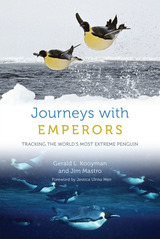
Journeys with Emperors
Tracking the World's Most Extreme Penguin
Gerald L. Kooyman and Jim Mastro
University of Chicago Press, 2023
With stunning photographs from the ice edge, a firsthand account of a researcher’s time in Antarctica and of the perilous journeys of the world’s largest penguin species: the iconic emperor.
Nearly all emperor penguin colonies are extremely remote; of the sixty-six known, fewer than thirty have been visited by humans, and even fewer have been the subject of successful research programs. One of the largest known emperor penguin colonies is found on a narrow band of sea ice attached to the Antarctic continent. In Journeys with Emperors, Gerald L. Kooyman and Jim Mastro take us to this far-flung colony in the Ross Sea, showing us how scientists gained access to it, and what they learned while living among the penguins as they raised their chicks.
The primary mission was to record the birds’ activities at sea, and the data revealed important aspects of emperor penguin behavior and physiology: for instance, that in the course of hunting for food, some of the penguins dive to depths of greater than five hundred meters (a third of a mile, which is deeper than for any other diving bird). The researchers also discovered that, crucially, most of the emperor’s life is actually spent at sea, with fledged chicks and adults making separate, perilous journeys through icy water. When chick nurturing is complete, the fledglings abandon the colony in large groups, heading north to the Southern Ocean. The adults leave at the same time, traveling one thousand kilometers eastward across the Ross Sea to a sea-ice sanctuary for molting. During this journey, they must gain enough weight to survive the month-long molt, when every feather is replaced and the birds cannot enter the water to feed. After the molt, many if not most return to the colony to breed once again. For the males, this means another fast—this time for 120 days as they incubate their eggs. The nearness of the colony to the ice edge spared the penguins the long, energy-draining march for which other colonies are well-known. It also allowed researchers to observe the penguins’ departures to and arrivals from their foraging journeys, as well as their dangerous interactions with leopard seals and killer whales.
Featuring original color photographs and complemented with online videos, Journeys with Emperors is both an eye-opening overview of the emperor penguin’s life and a thrilling tale of scientific discovery in one of the most remote, harsh, and beautiful places on Earth.
The primary mission was to record the birds’ activities at sea, and the data revealed important aspects of emperor penguin behavior and physiology: for instance, that in the course of hunting for food, some of the penguins dive to depths of greater than five hundred meters (a third of a mile, which is deeper than for any other diving bird). The researchers also discovered that, crucially, most of the emperor’s life is actually spent at sea, with fledged chicks and adults making separate, perilous journeys through icy water. When chick nurturing is complete, the fledglings abandon the colony in large groups, heading north to the Southern Ocean. The adults leave at the same time, traveling one thousand kilometers eastward across the Ross Sea to a sea-ice sanctuary for molting. During this journey, they must gain enough weight to survive the month-long molt, when every feather is replaced and the birds cannot enter the water to feed. After the molt, many if not most return to the colony to breed once again. For the males, this means another fast—this time for 120 days as they incubate their eggs. The nearness of the colony to the ice edge spared the penguins the long, energy-draining march for which other colonies are well-known. It also allowed researchers to observe the penguins’ departures to and arrivals from their foraging journeys, as well as their dangerous interactions with leopard seals and killer whales.
Featuring original color photographs and complemented with online videos, Journeys with Emperors is both an eye-opening overview of the emperor penguin’s life and a thrilling tale of scientific discovery in one of the most remote, harsh, and beautiful places on Earth.
[more]
READERS
Browse our collection.
PUBLISHERS
See BiblioVault's publisher services.
STUDENT SERVICES
Files for college accessibility offices.
UChicago Accessibility Resources
home | accessibility | search | about | contact us
BiblioVault ® 2001 - 2024
The University of Chicago Press









